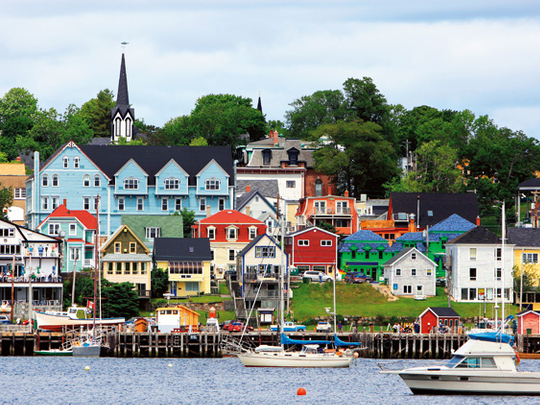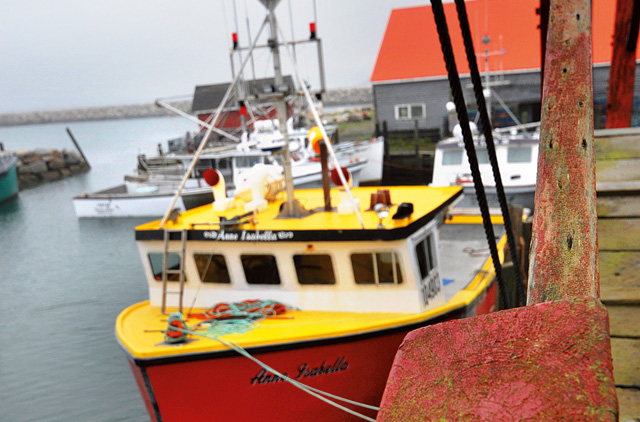
It took approximately seven seconds for Canada to shatter my preconceptions. I'd arrived in Nova Scotia believing the North American nation would be a) cold and b) inhospitable. Happily, I was wrong on both counts. Nova Scotia arcs deep into the North Atlantic Ocean, resting at a latitude similar to that of northern Italy, so the weather is generally warm. The locals are disarmingly friendly and offered a bright greeting: "Welcome to Nova Scotia," said the baggage handler as he helped me with my kart. "Happy to have you here," he added, in his East Canadian drawl.
I'd booked a week in Nova Scotia to enjoy the wide variety of attractions on offer, including dramatic scenery, a stunning coastline, sensational food, world-class history and phenomenal wildlife.
The province is at the forefront of 2012 commemorations for RMS Titanic, the world's most famous ship, which inspired the Oscar-winning movie. The world was stunned in 1912 by the loss of the luxury liner on its maiden voyage. Nova Scotia dispatched three Halifax ships to rescue those who had plunged into the icy waters and the region played a key role during the aftermath of the disaster.
Stark reminder of tragedy
Many victims found their final resting place in three Nova Scotian cemeteries, including the Fairview Cemetery, where three rows of Titanic headstones curve poignantly on a grassy hillside, as though creating the shape of the vessel. The black granite headstones are each inscribed with the same date, April 15, 1912 - a stark reminder of the disaster. Many visitors make a beeline for the stone of Jack Dawson, who was played by Leonardo DiCaprio in the 1997 movie.
Titanic artifacts are displayed at the Maritime Museum of the Atlantic, providing a touching reminder of the ship's lost luxury. Many items were pulled from the waters not long after the ship went down, including one of the only Titanic deckchairs known to exist. The 100th anniversary of the disaster will be marked throughout this year in a series of events that will evoke not only the tragic event but also the courage of locals who rushed to aid the stricken passengers.
The Titanic is not the only disaster to have struck here. The Halifax Explosion of December 1917 was the worst man-made explosion the world had ever seen, prior to the dropping of atomic bombs on Japan at the end of the Second World War. Two ships accidentally collided, and one ship was loaded with 2,300 tonnes of wet and dry picric acid, 200 tonnes of TNT, 35 tonnes of benzol and ten tonnes of gun cotton. The resulting explosion killed almost 2,000 people.
A glimpse into days gone by
Disaster-prone as it's been, Nova Scotia takes great pride in its history with numerous museums and heritage sites in the area, including the exceptional Fisheries Museum of the Atlantic. There are plenty of other must-visit sites with a nautical theme, such as Peggy's Cove, a gorgeously picturesque location that is the most photographed in North America. The Cove is around 40km from Halifax and is one of the best preserved fishing communities in North America, providing a glimpse into the life of fishermen from yesteryear. It was first used in 1766 and was named after the wife of an early settler. Its lighthouse is one of the busiest tourist attractions in the region, which provides the climax to a scenic drive.
Nova Scotia's landscape, food and history are intertwined. At Smuggler's Cove, rum-runners used to take their chances against the coastguard, hiding illicit cargoes, much of which had been dispatched to the region by Al Capone, America's best known gangster who led a Prohibition-era crime syndicate.
Enjoy a taste of the region
Much of the area's economy continues to revolve around the haul from the sea, and on the day we visited, the tide was out and we were able to clamber down steep steps to the Smuggler's Cove itself. It was easy to imagine the time when smugglers brought their illegal booty ashore. The cave was small and we made sure we were out before the tide started to come in again. We looked out towards St Mary's Bay, across the Bay of Fundy, and watched as waves crashed into the rocks below.
The following day, we visited Digby, the scallop capital of the world. We enjoyed driving through a seemingly endless succession of absurdly photogenic coves and ports that were filled with lobster boats and larger vessels that hauled in cod, haddock, halibut and other species.
Environmentally responsible visitor experiences allow tourists to learn more about the area. At the Bay of Fundy, we were able to dig for clams in wide, sandy beaches with Terry ‘The Clammer', whose father and grandfather also used to harvest the delicious molluscs. An afternoon in The Clammer's presence was a rare treat and our five-strong group was shown how to dig clams from just below the surface, before enjoying a delicious beachside lunch and being serenaded from The Clammer's guitar with the sort of songs Woody Guthrie might have been proud to call his own. The food was a treat and we ate clams that had been cooked in herbs and spices. Terry also allowed the braver among our group to eat raw clams, which had the sweet/salty taste of scallops and oysters.
No visit to Nova Scotia is complete without a trip on the high seas and we took a boat to spot dolphins, porpoises and whales. Our three-hour excursion was a highlight of our trip. We encountered eight gargantuan mammals, frolicking and feeding in the deep ocean blue. Humpback whales rose through the ocean crest, scooping up herring and other schooling fish, while fin whales - the greyhounds of the sea - ran faster than our boat as they sought out new feeding grounds.
The humpbacks were particularly playful. They rose majestically from the ocean, breaching with a 40-tonne thwack of the surface. Harbour porpoises, meanwhile, leapt playfully through the water, skimming the surface less than a mile from shore. At one point, a humpback whale rose gracefully less than a metre from the side of our boat, making one of the women onboard almost jump out of her skin as the creature's huge weight passed by her.
The abundance of oceanic life is celebrated in Nova Scotia's ample restaurants. The Five Fisherman, in Halifax, offers a menu that features scallops, live oysters (and wonderfully intense bison). The Salt Shaker, in Lunenburg, makes an exquisite lobster roll lunch, featuring hunks of seafood in a tarragon mayonnaise between a halved brioche bun; White Point Beach Resort serves up vast quantities of Indian Point mussels; the Garrison House Inn, at Annapolis, offered nautical fine dining; while Hall's Harbour Lobster Pound keeps live lobsters that are cooked to order and served with hot clarified butter.
Picture-perfect architecture
Homes throughout the region were built from cedar and maple and remain to this day. Towns like Lunenburg, a Unesco World Heritage Site, are thrillingly pretty with wooden board homes painted in all colours of the rainbow. Lunenburg's unique architecture provides the best example of planned British colonial settlement in North America.
The town has a long history of building wooden ships and the most famous is the world renowned schooner Bluenose - which became an important Canadian symbol in the 1930s after winning a series of races - and her daughter, Bluenose II. When we visited, Bluenose was in dry dock, being repaired by teams of skilled craftsmen who lovingly restored every centimetre.
Locals are fiercely proud of their heritage and the MacKinnon-Cann Inn, at 27 Willow Street, in Yarmouth, celebrates the region's architectural ancestry. A sumptuous inn has been restored at great cost, with each room representing a particular period of time. Guests can request their favourite - a lounge-ey 1960s room, ostentatious 1920s suite, or similar - and relax in suitably fitting surroundings.
Our time in Nova Scotia whizzed past and left us with memories that will last for many moons. Brimming with great food and opportunities for once-in-a-lifetime adventures, Nova Scotia also has world-beating landscape, dramatic history and lots more besides, making it the perfect everybody-wins family destination.
Travel log
- Getting there: Emirates flies from Dubai to Halifax and flights cost around Dh21,000. Visit www.emirates.com
- For further details of Nova Scotian holidays, visit www.novascotia.com.
- The award-winning MacKinnon-Cann Inn is on the Evangeline Trail on the southern shores: www.mackinnoncanninn.com





_resources1_16a08544951_small.jpg)








